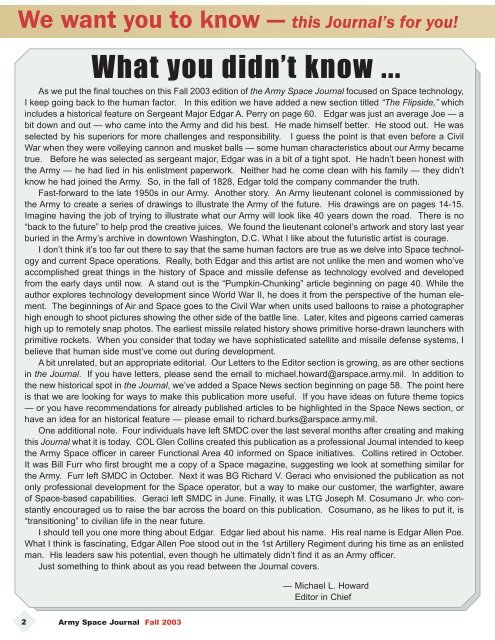Volume 2, Number 4 - Space and Missile Defense Command - U.S. ...
Volume 2, Number 4 - Space and Missile Defense Command - U.S. ...
Volume 2, Number 4 - Space and Missile Defense Command - U.S. ...
You also want an ePaper? Increase the reach of your titles
YUMPU automatically turns print PDFs into web optimized ePapers that Google loves.
We want you to know — this Journal’s for you!<br />
What you didn’t know ...<br />
As we put the final touches on this Fall 2003 edition of the Army <strong>Space</strong> Journal focused on <strong>Space</strong> technology,<br />
I keep going back to the human factor. In this edition we have added a new section titled “The Flipside,” which<br />
includes a historical feature on Sergeant Major Edgar A. Perry on page 60. Edgar was just an average Joe — a<br />
bit down <strong>and</strong> out — who came into the Army <strong>and</strong> did his best. He made himself better. He stood out. He was<br />
selected by his superiors for more challenges <strong>and</strong> responsibility. I guess the point is that even before a Civil<br />
War when they were volleying cannon <strong>and</strong> musket balls — some human characteristics about our Army became<br />
true. Before he was selected as sergeant major, Edgar was in a bit of a tight spot. He hadn’t been honest with<br />
the Army — he had lied in his enlistment paperwork. Neither had he come clean with his family — they didn’t<br />
know he had joined the Army. So, in the fall of 1828, Edgar told the company comm<strong>and</strong>er the truth.<br />
Fast-forward to the late 1950s in our Army. Another story. An Army lieutenant colonel is commissioned by<br />
the Army to create a series of drawings to illustrate the Army of the future. His drawings are on pages 14-15.<br />
Imagine having the job of trying to illustrate what our Army will look like 40 years down the road. There is no<br />
“back to the future” to help prod the creative juices. We found the lieutenant colonel’s artwork <strong>and</strong> story last year<br />
buried in the Army’s archive in downtown Washington, D.C. What I like about the futuristic artist is courage.<br />
I don’t think it’s too far out there to say that the same human factors are true as we delve into <strong>Space</strong> technology<br />
<strong>and</strong> current <strong>Space</strong> operations. Really, both Edgar <strong>and</strong> this artist are not unlike the men <strong>and</strong> women who’ve<br />
accomplished great things in the history of <strong>Space</strong> <strong>and</strong> missile defense as technology evolved <strong>and</strong> developed<br />
from the early days until now. A st<strong>and</strong> out is the “Pumpkin-Chunking” article beginning on page 40. While the<br />
author explores technology development since World War II, he does it from the perspective of the human element.<br />
The beginnings of Air <strong>and</strong> <strong>Space</strong> goes to the Civil War when units used balloons to raise a photographer<br />
high enough to shoot pictures showing the other side of the battle line. Later, kites <strong>and</strong> pigeons carried cameras<br />
high up to remotely snap photos. The earliest missile related history shows primitive horse-drawn launchers with<br />
primitive rockets. When you consider that today we have sophisticated satellite <strong>and</strong> missile defense systems, I<br />
believe that human side must’ve come out during development.<br />
A bit unrelated, but an appropriate editorial. Our Letters to the Editor section is growing, as are other sections<br />
in the Journal. If you have letters, please send the email to michael.howard@arspace.army.mil. In addition to<br />
the new historical spot in the Journal, we’ve added a <strong>Space</strong> News section beginning on page 58. The point here<br />
is that we are looking for ways to make this publication more useful. If you have ideas on future theme topics<br />
— or you have recommendations for already published articles to be highlighted in the <strong>Space</strong> News section, or<br />
have an idea for an historical feature — please email to richard.burks@arspace.army.mil.<br />
One additional note. Four individuals have left SMDC over the last several months after creating <strong>and</strong> making<br />
this Journal what it is today. COL Glen Collins created this publication as a professional Journal intended to keep<br />
the Army <strong>Space</strong> officer in career Functional Area 40 informed on <strong>Space</strong> initiatives. Collins retired in October.<br />
It was Bill Furr who first brought me a copy of a <strong>Space</strong> magazine, suggesting we look at something similar for<br />
the Army. Furr left SMDC in October. Next it was BG Richard V. Geraci who envisioned the publication as not<br />
only professional development for the <strong>Space</strong> operator, but a way to make our customer, the warfighter, aware<br />
of <strong>Space</strong>-based capabilities. Geraci left SMDC in June. Finally, it was LTG Joseph M. Cosumano Jr. who constantly<br />
encouraged us to raise the bar across the board on this publication. Cosumano, as he likes to put it, is<br />
“transitioning” to civilian life in the near future.<br />
I should tell you one more thing about Edgar. Edgar lied about his name. His real name is Edgar Allen Poe.<br />
What I think is fascinating, Edgar Allen Poe stood out in the 1st Artillery Regiment during his time as an enlisted<br />
man. His leaders saw his potential, even though he ultimately didn’t find it as an Army officer.<br />
Just something to think about as you read between the Journal covers.<br />
— Michael L. Howard<br />
Editor in Chief<br />
2<br />
Army <strong>Space</strong> Journal Fall 2003

















